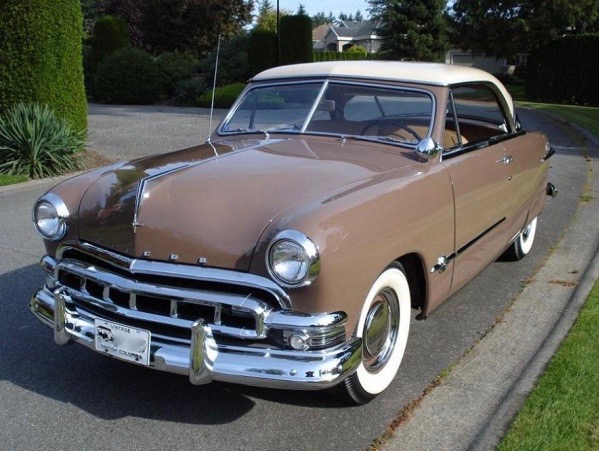Meteors were available for model years 1949-1961, inclusive. My information regarding how styling was accomplished is nil, so speculation follows. As can be seen below, until about 1960, Meteor styling -- ornamentation, actually -- often seems amateurishly done. Ford of Canada was a separate entity on those years, the U.S. Ford being a stockhholder. So I wonder if there was any kind of styling staff at all. Given the appearance of 1949-59 Meteors, my guess is that engineering staff dealt with styling.
Below are images of Meteors paired with those of U.S. Fords for the same model years.
1950 Meteor
1949 Ford
Fords for 1949 and 1950 had almost unnoticeable trim differences, and the same basically held for Meteors. The Meteor grille for those years was adapted from Mercurys.
1951 Meteor - sales photo
1951 Ford
Whoever designed the 1951 Meteor facelift did a pretty good job. I think it's at least on par with what Ford did, and might have been better if a medallion had been placed at the center of the grille.
1953 Meteor
1953 Ford
Meteors and Fords had little in the way of decorative differences for 1953. For Meteor, a few chromes strakes on the faux side air scoop, raised chrome strips atop the front fenders, and revised details at the center of the grille.
1955 Meteor
1955 Ford
1955 Meteors had garish side trim (though Ford's was awkward) and a fussy, garish grille.
1956 Meteor
1956 Ford
More Meteor amateurism for 1956. Grille and side trim are both awkward and garish.
1957 Ford
I always though 1957 Fords were nicely styled. Meteors continued their 1955-56 overdone ways.
1958 Meteor
1958 Ford
For 1958, Ford and Meteor styling almost converged. The main difference apparent here is some detailing on the middle of the grille opening.
1959 Meteor
1959 Ford
I never liked Ford's 1959 facelift and thought the slogan seen above was a joke. Meteor featured a slightly different grille and a bit more side trim.
1960 Meteor
1960 Ford
On the other hand, 1960 Fords were perhaps the best-looking American cars for that model year. The Meteor grill is nice, though I don't think those three four-pointed stars help it. The flash on the side trim is mini-garish.
1961 Meteor
1961 Ford
By now Meteor seems to benefit from what looks to be professional styling. Its grille is a little better than Ford's (except for those awful stars), and the rear treatment is a bit busy, yet interesting.





















































